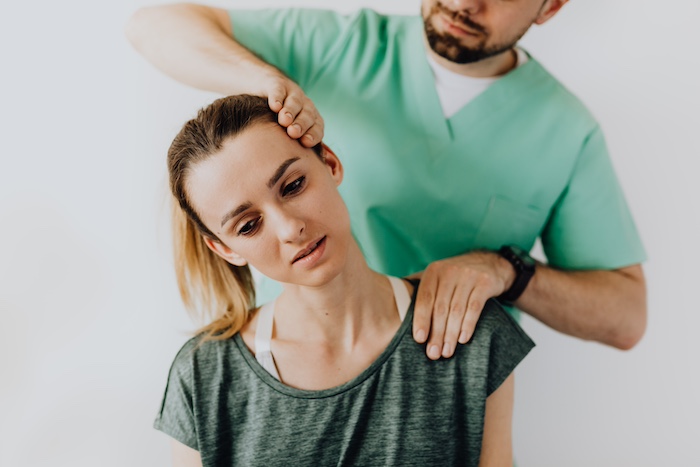
Soreness on the left side of your neck typically results from injury. However, some underlying conditions can cause neck pain.
Pain on the left side of the neck can be due to any number of causes, from muscle strains to a pinched nerve. Most causes aren’t serious.
A sore neck is likely due to sleeping in an odd position or holding your neck at an angle that stresses the muscles and tendons on that side.
In many cases, the pain on the left side of your neck will subside on its own or with over-the-counter pain relievers and rest. See a doctor if your pain is severe, is due to a recent injury, or if it lasts for more than a week.
Read on to learn about some of the more common and less common triggers of left-side neck pain, and how these conditions may be diagnosed and treated.
Common Causes Of Left-Side Neck Pain
Inflammation
Inflammation is the body’s response to injury or infection. It can cause pain, swelling, stiffness, numbness, and other symptoms.
Nonsteroidal anti-inflammatory drugs (NSAIDs) are usually the first line of defense in treating short-term pain and inflammation. Most can be bought over the counter (OTC).
Muscle Strain
If you spend hours leaning forward at your computer, cradling a phone between your right ear and your shoulder, or otherwise stressing your neck muscles, you can end up with pain on the left side of your neck.
Most muscle strains can be successfully treated at home with rest, ice, compression, and elevation (RICE).
Pinched Nerve
A pinched nerve (cervical radiculopathy) occurs when a nerve in the neck becomes irritated or squeezed as it branches out from the spinal cord. If it’s on the left side, it may also cause numbness and pain in the left shoulder.
Here are nine remedies for a pinched nerve. You can also try these exercises to relieve a pinched nerve in your neck.
Whiplash
You can get whiplash when your head is forcefully thrust back and forth. This can happen from a football tackle, a vehicle accident, or a similar violent incident.
Whiplash can often lead to a painful neck injury. Neck stiffness and headaches are among the other common symptoms of whiplash.
Doctors typically prescribe OTC pain medications like acetaminophen (Tylenol) or aspirin (Bufferin) to relieve symptoms of whiplash. More severe injuries may require prescription painkillers and muscle relaxants to reduce muscle spasms.
In addition to medication, you may also want to apply ice or heat to the injured area.
You might also be given a foam collar to keep your neck stable. Collars should only be used the first couple of days after your injury and worn no more than three hours at a time.
Acute Torticollis
Acute torticollis occurs when the muscles in your neck suddenly contract, causing your head to twist to one side.
It usually causes pain on one side of the neck and may be triggered by sleeping awkwardly without much head support. It can also be caused by poor posture or even leaving your neck exposed too long in cold temperatures.
Traction, stretching exercises, and massage may help to relieve pain. Applying heat is also recommended.
Less Common Causes Of Left-Side Neck Pain
Cervical Fracture
The seven bones at the top of the vertebrae are known as the cervical vertebrae. A cervical fracture, also known as a broken neck, can occur from violent contact in sports, serious falls, vehicle accidents, or other traumatic injuries.
The most serious risk with a cervical fracture is damage to the spinal cord.
Cervical Disc Degeneration
In between the bones in your vertebrae are tough, but flexible discs that serve as shock absorbers to protect the bones.
The outside of each disc is the annulus fibrosis, a tough structure that encloses a fluid-filled nucleus, the nucleus pulpous.
Over time, these discs become less flexible. The annulus fibrosis may degenerate and tear, leading to the material of the nucleus pulpous impinging or resting on the spinal cord or a nerve root. This can result in neck pain.
Herniated Cervical Disc
A herniated cervical disc occurs when the tough outer layer of a cervical disc tears and allows the nucleus to push through and press on the nerves and spinal cord encased in the vertebrae.
In addition to pain in the neck, the condition can cause numbness, weakness, or tingling that can extend down into the arms.
Meningitis
Meningitis is usually caused by a virus, but there are also bacterial, fungal, and parasitic versions of the inflammatory condition. It can cause pain and stiffness in the neck, as well as headaches.
Untreated bacterial meningitis can lead to brain swelling and seizures.
Rheumatoid Arthritis
Rheumatoid arthritis is an inflammatory disease that affects about 1.3 million Americans. It damages the lining of the joints and can cause considerable pain, stiffness, numbness, and muscle weakness.
Pain from this condition may be felt on the left or right side, or in the middle of the neck, depending on which part of the joint is affected.
Osteoporosis
The bone-thinning disease called osteoporosis doesn’t always bring on symptoms, but it does raise the risk of painful fractures of the cervical vertebrae.
Fibromyalgia
The cause of fibromyalgia remains unknown, and it affects each person who has it a little differently. It may cause pain in the neck and throughout the body and can be challenging to treat.
Spinal Stenosis
Spinal stenosis is a narrowing of the spinal canal, which results in a pinching of the spinal cord or nerves extending from the spinal cord. This condition, caused by osteoarthritis, can occur in the cervical vertebrae and down the spine to the lower back.
Heart Attack
In some cases, pain anywhere in the neck can be a sign of a heart attack. But there will usually be other noticeable symptoms, such as pain in the jaw, arm, or back, as well as shortness of breath, nausea, and a cold sweat.
Women are more likely than men to report non-chest pain as a heart attack symptom.
Rare Causes Of Left-Side Neck Pain
Spinal Tumors
A spinal tumor is a growth that forms within the spinal canal or the bones of your spine. It may be benign (noncancerous) or cancerous and can cause pain at the site of the tumor.
Muscle weakness is another common sign. Symptoms tend to worsen until the tumor is treated.
Congenital Abnormalities
A range of conditions can affect newborn babies, causing pain on the left side of the neck and other similar symptoms. Among them are:
- congenital torticollis, in which the neck is injured during delivery
- congenital vertebral defects, which can include abnormally shaped cervical vertebrae.
Pain on the left side of your neck that lasts for more than a week and doesn’t respond to treatment should be evaluated by a doctor.
If you start to feel pain running down your arms or legs, or you feel a numbness or tingling sensation in your neck, see a doctor as soon as you can. Neck pain accompanied by a headache should also be evaluated promptly.
If neck pain is the result of an obvious incident, such as a car accident, fall, or sports injury, seek medical attention immediately.
Diagnosing Left-Side Neck Pain
When you see a doctor about pain on the left side of your neck, they’ll first give you a physical examination. They’ll check your range of motion and areas of tenderness, swelling, numbness, weakness, and the specific areas causing you pain.
The doctor will also review your medical history and discuss any other symptoms you may be experiencing.
Screening tests may also be recommended. These include:
- X-rays
- magnetic resonance imaging (MRI)
- computed tomography (CT) scans
The right treatment for your neck pain depends on your condition, its severity, and your overall health.
For minor neck pain, try a heating pad or a hot shower for 20 minutes or so at a time for the first two to three days. Then use ice packs for 10 to 20 minutes several times a day.
Home Remedies
Here are a few other simple remedies and lifestyle tips to try:
- Practice gentle, slow stretching.
- Try massage.
- Sleep with a special neck pillow.
- Take anti-inflammatory medication, such as ibuprofen (Advil).
- Use good posture when standing, sitting, and walking.
- Adjust your chair so that your eyes are looking straight at your computer screen.
- Sleep with your head and neck aligned with the rest of your body.
- Avoid carrying heavy suitcases or other items that pull too much on one shoulder.
Physical Therapy
You may be advised to have physical therapy to help relieve your pain. In addition, you’ll learn exercises, posture changes, and other adjustments you can make to feel better and prevent future problems.
Corticosteroid Injections
You may also need a procedure to relieve your pain or correct a problem in your neck.
Depending on the source of the pain, your doctor may inject corticosteroid medications into the nerve roots, muscles, or in between bones of the vertebrae on the left side of your neck to relieve the pain and reduce inflammation.
Surgery
If your spinal cord or nerve roots are being compressed, or if there’s a fracture to be repaired, surgery may be necessary.
Sometimes wearing a neck brace is enough to keep the cervical vertebrae stable while they heal without surgery.
Nonspecific pain on the left side of the neck meaning pain that’s not caused by a specific injury or condition is a common occurrence.
Nonspecific neck pain affects about two-thirds of people at some stage in life, more often in middle age.
Most neck pain that develops from muscle strain or similar causes usually disappears with rest after a few days. If your pain lingers for more than a week or is accompanied by other symptoms, seek medical attention.
The pain may still be due to a muscle strain that’s just taking longer to heal, but getting a thorough medical evaluation will keep you from guessing if it might be something more serious.
Precision Pain Care and Rehabilitation has two convenient locations in Richmond Hill – Queens, and New Hyde Park – Long Island. Call the Queens office at (718) 215-1888 or (516) 419-4480 for the Long Island office to arrange an appointment with our Interventional Pain Management Specialists, Dr. Jeffrey Chacko or Dr. Sonny Ahluwalia.













